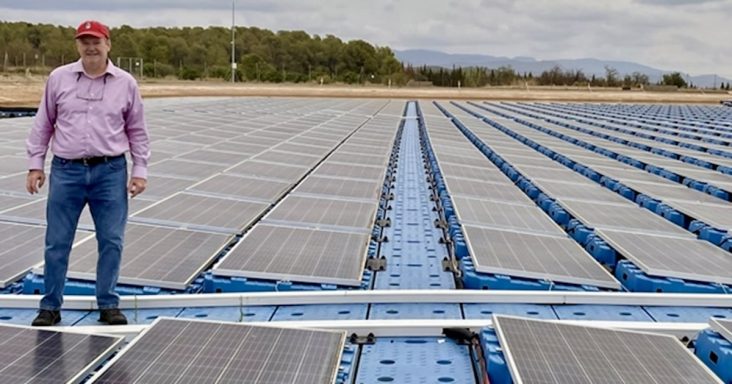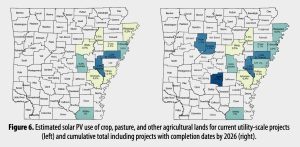Large solar arrays on less than 1% of Arkansas agri land
by June 2, 2025 10:50 am 634 views

Mike Popp, the Harold F. Ohlendorf Professor of agricultural economics and agribusiness, stands atop a floating solar array at a reservoir in Spain. (photo courtesy of the University of Arkansas)
Large-scale solar power facilities are on about 0.2% of Arkansas agricultural land, with utility-scale solar ranging in land use between 445 acres for a 50-megawatt site to 2,670 acres for a 300-megawatt site, according to a University of Arkansas report.
“With the Arkansas economy more reliant on agriculture compared to the nation and surrounding states, diversion of agricultural land to other uses draws producer and consumer interest,” said Mike Popp, the Harold F. Ohlendorf Professor of agricultural economics and agribusiness and co-author of a “Agricultural Land Footprint of Solar Photovoltaic Installations in Arkansas.”
The report noted that solar facilities have minimal impact on crop prices, there are concerns about proximal real estate value impacts, exposure to weather risk and land restoration considerations exist.
By 2026, there will be 15 counties in Arkansas, mostly in the agricultural-dominated Delta, with utility-scale solar arrays. Utility-scale is defined as 20 megawatts or larger. Currently, 11 counties have these large-scale solar projects on lands defined by a U.S. Department of Agricultural census as agricultural land. Four more utility-scale projects are scheduled through 2026, including one in Grant County on land considered “woodland or timberland areas.”
Using information gathered from the U.S. Energy Information Administration, the new report indicates that utility-scale solar arrays will occupy 0.2% of the state’s 13.7 million acres of agricultural land under projections through 2026. In counties where larger solar arrays are used, land use ranges from 0.2% to 1.7% of agricultural land.

“Even under this extreme level of solar development, which is unlikely to happen, solar would use less than 1% of the 13.7 million acres of agricultural land,” Popp said.
Following are other items in the UA report.
• Solar energy generation has nearly doubled in efficiency in the past decade. To produce one megawatt – enough to power roughly 150-200 homes annually – about 5.5 acres of land is required, according to a 2022 study cited by the authors. By contrast, a 2013 study showed that one megawatt of solar energy production required about nine acres of land.
• The number of solar arrays in Arkansas has also grown in recent years, with 1,100 megawatts added in 2024 and another 400 megawatts scheduled for this year.
• According to USDA data cited by the researchers, solar projects have removed less than 0.05% of land from agricultural purposes nationwide.
• With about 28,000 acres of agricultural land composed of irrigation reservoirs, floating solar arrays have become an interesting area for research to decrease impact on agricultural land use.
• Several other opportunities exist for solar power systems to integrate with agriculture, known as “agrivoltaics,” Popp said. Combining solar installations with sheep grazing and honeybee management are commonly cited examples of agrivoltaics.
